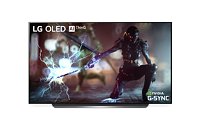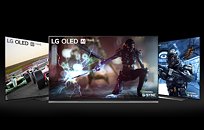Friday, November 1st 2019

LG OLED TVs Receive NVIDIA G-SYNC Upgrade Starting This Week
LG Electronics USA announced that 2019 OLED TVs are receiving a firmware update starting this week, enabling stunning game play via NVIDIA G-SYNC Compatible technology.
NVIDIA G-SYNC Compatible support will be available on the E9 series (65 and 55 inches) and C9 series (77, 65 and 55 inches) as well as the B9 series (65 and 55 inches) LG OLED TV models in the United States in November.With G-SYNC Compatible support, the critically-acclaimed LG OLED TVs will deliver the smoothest, most immersive gaming experience without the flicker, tearing or stuttering common to most displays. Gamers have long valued LG OLED TVs for their exceptional picture quality, low input lag and ultra-fast response time. The addition of G-SYNC Compatible support allows gamers with GeForce RTX 20-Series or GTX 16-Series GPUs to fully enjoy extreme responsiveness and optimized visuals on LG's large OLED TVs from 55 inches up to an immersive 77 inches.
"If you'll pardon the pun, this is truly a game changer for the legions of gamers out there," said Tim Alessi, head of home entertainment product marketing at LG Electronics USA. "Partnering with NVIDIA to integrate their G-SYNC Compatible support into our category-leading LG OLED TVs delivers a new standard in gaming performance and opens a new world of large-screen 4K gaming experiences only found on LG OLED TVs."
For more information on LG TVs, visit LG.com.
NVIDIA G-SYNC Compatible support will be available on the E9 series (65 and 55 inches) and C9 series (77, 65 and 55 inches) as well as the B9 series (65 and 55 inches) LG OLED TV models in the United States in November.With G-SYNC Compatible support, the critically-acclaimed LG OLED TVs will deliver the smoothest, most immersive gaming experience without the flicker, tearing or stuttering common to most displays. Gamers have long valued LG OLED TVs for their exceptional picture quality, low input lag and ultra-fast response time. The addition of G-SYNC Compatible support allows gamers with GeForce RTX 20-Series or GTX 16-Series GPUs to fully enjoy extreme responsiveness and optimized visuals on LG's large OLED TVs from 55 inches up to an immersive 77 inches.
"If you'll pardon the pun, this is truly a game changer for the legions of gamers out there," said Tim Alessi, head of home entertainment product marketing at LG Electronics USA. "Partnering with NVIDIA to integrate their G-SYNC Compatible support into our category-leading LG OLED TVs delivers a new standard in gaming performance and opens a new world of large-screen 4K gaming experiences only found on LG OLED TVs."
For more information on LG TVs, visit LG.com.


60 Comments on LG OLED TVs Receive NVIDIA G-SYNC Upgrade Starting This Week
"NVIDIA G-SYNC Compatible" - as in article - has nothing to do with G-Sync.
In monitors (Display Port)-- it is either Adaptive Sync (called also Freesync) -- a standard developed by AMD and VESA consortium, or -
in Monitors/TVs (through HDMI) - it is VRR (Variable Refresh Rate) - a standard developed by AMD and HDMI consortium (also sometimes called Freesync through HDMI).
Nvidia played no role in developing both of these standards.
What they "only" did is - after a few years of milking their G-Sync fanbase they partially stopped, and agreed to support the free standards...eventually... but as we see even this they try to sell as their own....
Shady marketing practices...
Freesync over HDMI is not a standard but AMD proprietary technology.
LG 2019 models have HDMI 2.1 with its optional standard VRR.
Overall though yes I agree with you, but I also understand their side of it, but they could word it different.
The onboard chip also did most of the heavy lifting so the framerate drops weren't as anywhere as precipitous as freesync. It could've been developed into something much better
2013 October - Nvidia demos Gsync.
2013 December - Nvidia releases Gsync Module that basically fails to do anything market-wise.
2014 January - Gsync monitors are released, wider availability in spring.
2014 January - AMD demos prototype Freesync on laptops and eDP.
2014 May - Displayport 1.2a standard gets optional Adaptive-sync added.
2015 March - AMD announces Freesync
2015 Summer - Freesync-over-HDMI is demoed.
2015 Autumn - Availability of Freesync monitors.
2015 November - LFC is introduced.
2015 December - Freesync-over-HDMI is launched with monitor availability in early 2016.
Gsync (the one with the module) has been a static thing from the beginning when it comes to features and VRR-related specs. High refresh rates, frame-doubling/LFC. When you see Gsync logo, this is what you know you get.
First batch of Freesync monitors at release (1.5 years after Gsync release ) had a lot of 48-75Hz monitors and even for monitors that were capable, LFC was released another quarter later.
For almost 2 years, Freesync was not on par with Gsync in a purely technical level. After that it took another year or so for significant amount of competitive Freesync monitors to appear.
This is why Nvidia went for proprietary solution and their own scaler hardware. At that point there were no other solutions available.
I did not like the price part of that equation and AMD's inability to compete at high end GPU market for a significant amount of time definitely played a part here. Trying to look at it objectively though - judging by the trouble AMD had to go through to get traction on VRR standards in terms of monitors on the market, I really cannot blame Nvidia for going this way.
Edit:
AMD made significant mistakes with Freesync as well. They clearly went to quantity over quality. Any DP Adaptive-sync capable monitor gets Freesync logo. Some that do not work well and some that are not authorized by AMD (Freesync is their logo so they should authorize monitors to have it). This is what left the door open for Gsync Compatible. If we overlook the AMD vs Nvidia thing, compared to Freesync Gsync Compatible has significantly more restrictive requirements and monitors are more closely scrutinized before certifying them. This makes it a more desirable logo to have.
Both AMD and Nvidia seem to have overestimated significance (or rather, availability) of HDR in the monitor market with both Freesync2 and Gsync Ultimate. Both are effectively stillborn.
Edit2:
Leaving logos and marketing aside, VRR fortunately seems to be well on the road to ubiquity. DP Adaptive Sync is there for most higher-refresh rate monitors, HDMI 2.1 is coming and brings its standard VRR with it. All good things. I wish we could get rid of both Freesync and Gsync branding but that's unfortunately not likely to happen.
I wonder if there is any money involved or if it's simply a partnership meant to benefit both parties. I'd really be interested to know the answer to that, because it's possible there are some shenanigans going on here considering that AMD is more-or-less the proprietor of VRR via HDMI 2.0b and earlier versions.
Given that LG 2019 OLEDs have HDMI 2.1 with VRR, it is most likely that Nvidia's Gsync Compatible thing here is same type of mixed tech - HDMI 2.1 VRR signaling from HDMI 2.0 source.No. Might need custom firmware developed with AMD though.
Pretty sure when GPUs with HDMI 2.1 come out - next gen for both manufacturer's I would assume - this will be a moot point.
Important technical bit about this news is that you can get 1440p@120hz (40-120Hz range) or 2160p@60hz (40-60Hz range).
Tvs can do 2160p@120Hz but it simply won't fit through HDMI 2.0.
"...Radeon™ Software will add support for HDMI 2.1 Variable Refresh Rate (VRR) technology on Radeon™ RX products in an upcoming driver release. This support will come as an addition to the Radeon™ FreeSync technology umbrella, as displays with HDMI 2.1 VRR support reach market."
So, I believe these new TVs should work fine with AMD cards if/when there is a driver update that enables support. For all I know, support is already built-in to current AMD drivers. If it turns out the TVs won't work with AMD cards, then I think people should cry foul since the HDMI 2.1 standard should be brand/manufacturer analogous and indiscriminate.
My Samsung QLED TV fully supports VRR via HDMI, but it's using HDMI 2.0b and, presumably, some sort of AMD-developed, proprietary technology or IP since it predates HDMI 2.1 VRR. Currently, VRR on my TV won't work with my GTX 1070 (via HDMI), but it works fine with Polaris and newer AMD cards. The real disappointment is that it seems Nvidia might arbitrarily block or otherwise fail to support Pascal/10-Series and Maxwell/900-Series cards from using VRR via HDMI 2.1, even if a driver update could enable it. Those of us with 10- and/or 900-Series cards should make enough noise to get Nvidia to add support, if possible.Exactly, and that's currently what I can do on my Samsung QLED, except that it actually supports down to 20 Hz at 1440p, supposedly. Because of the limited VRR range at 2160p/4K, I usually run games at 1440p @ 120 Hz, which the 5700 XT I'm currently using is better equipped for, anyway.
And AMD is 35% of discrete GPU market and nearly 100% of console market, want to talk about it?
No, it makes no sense to piss on a sizable (if not greater. as consoles are almost guaranteed to be connected to a TV, unlike PCs)) part of your customer base.
Most likely yet another portion of shady shit from NV, such as "you can advertise it as NV compatible, only if you avoid mentioning FreeSync".
If monitor or TV supports DP adaptive sync or HDMI 2.1 VRR, I could not care less if the box or logos on it are red, green or blue.
On the other hand it is too much optimism expecting companies to stop branding things so logos will inevitably be there.
Also, I'd like to point out how the following attitude is completely toxic and counterproductive:
"Well, who cares if Nvidia does underhanded tactics and strategies, all companies do it"
Just because despicable behavior becomes ubiquitous, doesn't make it any more justified or less despicable. Just throwing up your hands and shrugging and saying "oh well, there's nothing I can do about it" is the exact reason why this behavior has become common place and the reason why it will continue to be.
Fighting against this behavior isn't about being pro-AMD or anti-Nvidia and any fan boys who try an place it in that context or doing so either to knowingly or ignorantly silence debate in discussion by seating the discussion in the false binary of AMD vs Nvidia when it has nothing to do with that. ALL behavior that results in negative consequences for the PC community (even the ones too blinded by their own loyalties to understand that) should be zealously fought against regardless of the source.
- LG 2019 OLED TVs have HDMI 2.1 with VRR support. Very much a standard thing.
- What Nvidia arranged was to add support for the same feature in their current GPU lineup that only has HDMI 2.0.
- No extra cost, no effect to the standard feature.
What exactly is here to be upset about?
What vendor lock? Deceiving how?